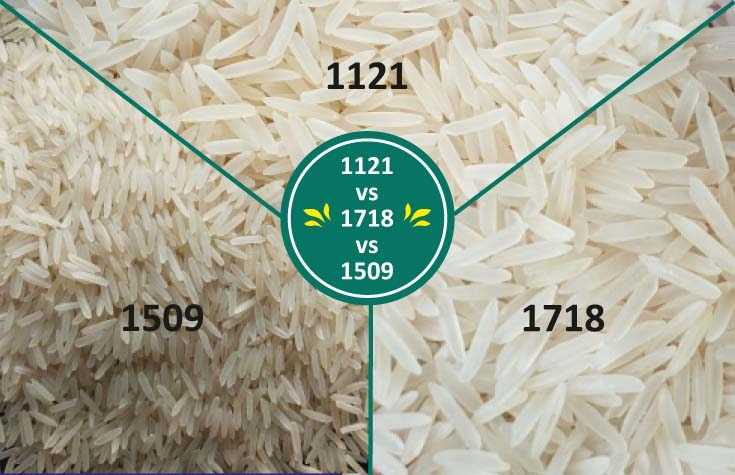Basmati rice, celebrated for its aroma, flavor, and long grains, comes in several varieties, each with unique characteristics that cater to different preferences and culinary uses. In this blog post, we delve into the differences between three popular basmati varieties: Basmati 1121, Basmati 1718, and Basmati 1509.
| Feature | Basmati 1121 | Basmati 1718 | Basmati 1509 |
|---|---|---|---|
| Aroma | Floral, popcorn-like | Mild, slightly nutty | Strong, traditional basmati |
| Flavor | Delicate | Subtle | Robust, slightly sweet |
| Grain Length (mm) | 8.2 – 8.4 | 7.5 – 7.7 | 7.8 – 8.0 |
| Cooking Characteristics | Fluffy, separate grains | Fluffy, retains shape | Fluffy, good elongation |
| Culinary Uses | Premium dishes, fine dining | Everyday cooking | Versatile, various dishes |
Basmati 1121
Aroma and Flavor: Basmati 1121 is renowned for its exceptional aroma, often described as floral or popcorn-like. It has a delicate flavor that enhances the overall dining experience.
Grain Length: It is characterized by long grains, typically ranging from 8.2 to 8.4 mm, which contribute to its premium quality and visual appeal.
Cooking Characteristics: When cooked, Basmati 1121 grains remain separate and fluffy, making it ideal for biryanis, pilafs, and other dishes where distinct grains are desired.
Culinary Uses: Due to its aroma and grain length, Basmati 1121 is favored in fine dining, gourmet cuisines, and special occasions where quality and presentation are paramount.
Basmati 1718
Aroma and Flavor: Basmati 1718 offers a mild, pleasant aroma with a slightly nutty undertone. Its flavor is subtle, making it versatile for various culinary applications.
Grain Length: Grains of Basmati 1718 are typically shorter compared to Basmati 1121, ranging from 7.5 to 7.7 mm. However, they still exhibit the characteristic slender shape of basmati rice.
Cooking Characteristics: It cooks well, producing fluffy grains that retain their shape and absorb flavors effectively, suitable for a wide range of rice dishes.
Culinary Uses: Basmati 1718 is preferred in everyday cooking, including pilafs, rice bowls, and mixed rice dishes, where its balanced flavor and cooking properties shine.
Basmati 1509
Aroma and Flavor: Basmati 1509 is known for its strong aroma, reminiscent of traditional basmati fragrance with a slightly sweet note. Its flavor is robust, enhancing dishes with a distinct taste.
Grain Length: Grains of Basmati 1509 are longer than Basmati 1718 but shorter than Basmati 1121, typically ranging from 7.8 to 8.0 mm. They are slender and elongated, characteristic of basmati rice.
Cooking Characteristics: It cooks to a fluffy texture, offering excellent elongation and separation of grains. This makes Basmati 1509 suitable for a variety of dishes where texture and aroma are key.
Culinary Uses: Basmati 1509 is versatile in both everyday cooking and special occasions, including dishes like pulao, fried rice, and other rice-based delicacies where aroma and flavor are essential components.
Choosing the Right Basmati Variety
When selecting basmati rice, consider the following factors:
- Usage: Determine whether you need rice for daily meals or special occasions.
- Aroma and Flavor Preferences: Choose based on the intensity and type of aroma you prefer in your dishes.
- Cooking Properties: Consider how well the rice holds up during cooking and its ability to absorb flavors.
Summary:
- Basmati 1121: Known for its exceptional aroma and long, slender grains, ideal for premium dishes and special occasions.
- Basmati 1718: Offers a mild aroma with balanced flavor, suitable for everyday cooking and mixed rice dishes.
- Basmati 1509: Strong aroma and robust flavor, versatile for a wide range of dishes, including pulao and fried rice.
Conclusion
Basmati rice varieties like 1121, 1718, and 1509 each offer distinct characteristics in terms of aroma, flavor, grain length, and culinary versatility. Whether you seek the premium aroma of Basmati 1121, the balanced flavor of Basmati 1718, or the robust profile of Basmati 1509, each variety caters to different culinary needs and preferences.
Exploring these differences allows you to appreciate the diversity within the world of basmati rice and make informed choices based on your cooking style and desired dining experience. Embrace the richness of basmati rice varieties in your culinary adventures, enhancing every meal with the unique attributes they bring to the table.






